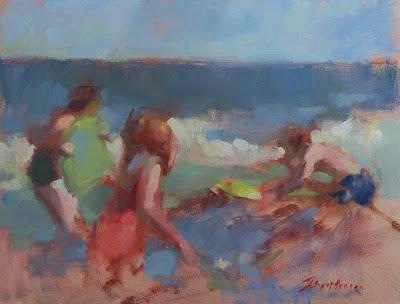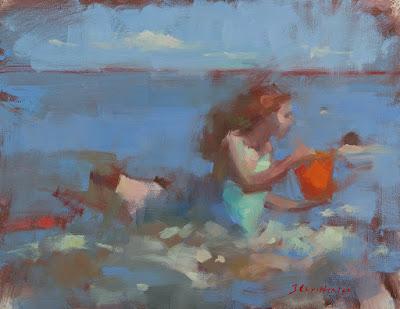
Brushes used: well loaded hogs bristle flats and filberts with thick, tube consistency paint. Smaller, dense, light marks in the waves in the middle of the image were synthetic filberts. Thin lines are made with a crisp, long flat used on its edge. If the line had more modulation across its length, I'd have said it was an eggbert.

Brushes used: Hogs bristle flats and filberts for most for most of the work. Notice the broken edge at the end of the stroke of the figure on the body board. That shows it was a hogs bristle. The start of the stroke is very straight suggesting it was a flat brush. Synthetic flats for dense, full coverage passages such as the orange light on the pail. Synthetic eggbert for the drawing elements such as the reddish, drawn underpainting of the body boards on the left and for the clouds (pushing motion for those)

There are so many brushes on the shelves of art stores and it can be truly baffling to choose the right one, so I thought I'd do a post that touches on the basics of brushes and their uses.
Choosing a brush comes down to what you want to do with it; what effect you hold in your mind that you're trying to replicate on the canvas. That, actually, is the biggest consideration when picking a brush: know what you want it to do.
I like to layer paint, wet in wet, and I don't like a picky, small-detail look, so I need large brushes with long bristles. They have to be long because short, stiff bristles tend to remove more than they apply when placing wet paint over a wet layer. So long filberts or flats are my choice for layering. They also need to be springy, not wet noodly, so that they can hold a lot of paint and don't require me to press them onto the canvas to release that paint. I should be able to gently stroke a well loaded brush over a wet layer, and leave behind a relatively clean layer on top of it.
The worst brush to buy if you want to layer alla prima is the bright. This is a short, stiff-bristled flat that's great for laying a crisp, firm mark, but won't let you layer any better than a stick would. Brights remove the wet layer rather than adding to it. If you work in single layers or let the paint dry between layers, this brush would be fine.
The next consideration is the type of bristle that you choose. From natural bristle to synthetic, stiff to soft, there are a lot of options to choose from. My preference is hog bristle (which is a springy, natural bristle) because they also help me to layer. When I lay a coat of paint over a wet layer, hog bristle separates slightly, allowing the underlayer to show through like strands of different coloured hair interlaced with each other. The show through is livelier than a single color painted like house paint: densely closed and with full coverage.
The only other natural bristle that I've tried is mongoose, and it can do the same thing as hog bristle, but, because it's such a soft bristle, it can't be as heavily loaded and your oil paint must be diluted. You'll end up with a thinner paint surface and greater delicacy in the final look. Hog bristle will create a chunkier, rougher final work.
When it comes to synthetic brushes, there are also a lot of different types to choose from. Some are meant to mimic hog bristle, or sable, and others are entirely their own, unique thing. I haven't yet found a mimic that actually acts just like my hog bristle, though. Synthetics generally hold their shape much better during a mark, meaning that they don't spread apart in the random manner of natural bristle, and the resulting marks can be more dense and closed because of this. It takes an extremely light touch to create the "break" in the mark if you're using synthetics, and I tend to use them only in passages where a want a single layer that looks fairly uniform, or to place an obliterating mark over a lower layer. Synthetics are great for making thick, showy marks towards the end of a painting because springy synthetics tend to hold a lot of paint and can place it very cleanly and distinctly on top of other paint.
Other useful brushes are rounds and eggberts, both of which I use fairly often. Rounds will give a linear mark (think Van Gogh), but can also be used in a side-to-side, scribbling fashion to create patches of color. And, when they're pushed, rather than pulled, you can get interesting effects that don't clearly show the shape of the brush that made them. Up until the invention of the metal ferrule in the 18th century, all brushes in the western world were round, and you can see from historical paintings that there was no shortage of varied and interesting brushwork to be had from this shape.
Eggberts are filberts with double-length bristles. Like Chinese calligraphy brushes, they bend gracefully and are capable of a variety of thicknesses in their marks depending on the pressure or twist applied to them during the mark making. They can be quite calligraphic and a bit random because their length makes them hard to use with great precision. Used in a side-to-side fashion, eggberts can make a rather irregularly filled patch, especially if they're made of natural material. Synthetic eggberts will hold together better than natural bristle and not look as random in the final paint patch. They allow greater control (not always a good thing).
Of course, you can overcome any shape's limitations by using the brush in a variety of ways. Many painters just use the tip of their brushes, but if they use the edge they can create quite different marks, and if they push or wiggle or scribble the brush, it can increase its mark making range considerably, as can varying the paint quantity and consistency.
And, lastly, some stuff about cleaning and maintenance. Synthetics can take a final soap and water wash (and should get one as they tend to get stiff without it), but natural bristles don't like it. I've used my students' brushes on occasion, and I can always tell if they've been in water because the hog bristle is soft and splayed and has lost its springiness as water was absorbed into the bristles. Since reading about this effect a couple of years ago in an article on the Utrecht site, I've both cut down on brush cleaning time and extended the crisp, useful state of my natural bristle brushes significantly. They get a thorough wipe, then solvent, then another wipe, and that's it. This will help your brushes last longer, but they're not indestructible. All brushes wear down and become blunt and less precise. That's when you should designate them for a different purpose in your painting and buy new ones.
At the moment I'm enjoying a big order of Rosemary & Co brushes and trying to be kind to them. My old, worn brushes are reserved for scrubbing on tones while the Rosemarys are used for the crisper, more precise work that makes up the upper layers of a painting. My current favorite is the Ultimate Bristle (hog bristle) in filbert and flat, but I'm also loving the synthetic Ivory eggbert. I'm finding that I don't use the Ivory in other shapes as often as the hog bristle because it keeps the mark too closed for my purposes. I need marks to break apart a bit.
There's much more to explore about brushes but this should give you some insight into how I approach choosing a brush. I'd be interested to hear about your favorite brushes and what they're good at. Images of the marks they make a would make my day!
Happy painting!

